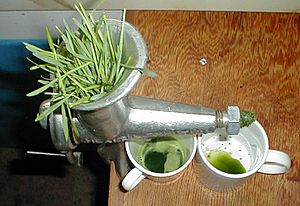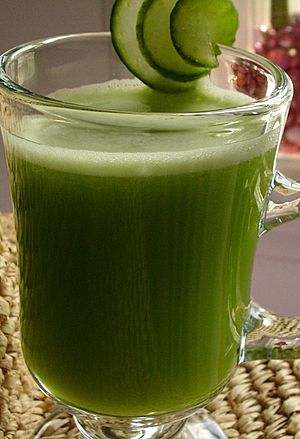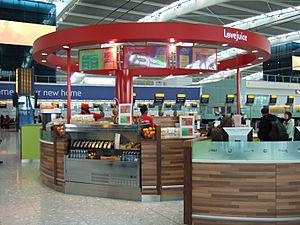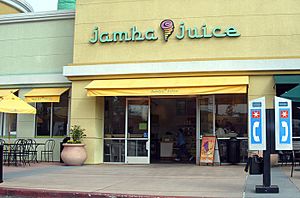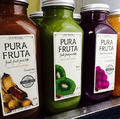Juice facts for kids
Juice is a popular drink made by squeezing or pressing the natural liquid from fruits and vegetables. It can also be a liquid flavored with concentrate or other food sources, like meat or seafood (think clam juice). People often drink juice on its own or use it as an ingredient in foods, like in smoothies.
Juice became a very popular drink after people learned how to pasteurize it. This process helps keep juice fresh without it turning into wine through fermentation. Today, countries like New Zealand and Colombia drink a lot of fruit juice. Generally, people in richer countries tend to drink more fruit juice.
Contents
How Juice is Made
Juice is made by pressing the flesh of fruits or vegetables. This is done without using heat or special chemicals. For example, orange juice comes from squeezing oranges, and tomato juice is made by pressing tomatoes.
You can make juice at home using a juicer, which can be hand-powered or electric. Many juices you buy in stores are filtered to remove pulp or fiber. However, some people prefer orange juice with lots of pulp! Sometimes, things like sugar, artificial flavors, or savory seasonings (like in Clamato) are added to juices.
Common ways to keep juice fresh for a long time include canning, pasteurization, making it into a concentrate, freezing, and evaporation.
Steps to Make Commercial Juice
Even though different juices are made in slightly different ways, here are the general steps:
- First, the fruits or vegetables are washed and sorted.
- Then, the juice is extracted.
- Next, it's strained, filtered, and made clear.
- After that, it's often blended and pasteurized (heated to kill germs).
- Finally, the juice is put into containers, sealed, and cooled. Then it's labeled and packed up.
After fruits are picked and cleaned, machines extract the juice. One way is using two metal cups that squeeze the fruit. Sharp tubes remove the peel and push the fruit's flesh through. The juice then comes out through small holes. The peels can even be used later to get oils from them! Another method involves cutting fruits in half and using special tools called reamers to squeeze out the juice.
Juice Concentrate
After filtering, juice can be made into a concentrate using evaporators. This process removes about two-thirds of the water, making the juice much smaller and easier to transport. It also helps the juice last longer. Juices are concentrated by heating them in a vacuum to remove water, then cooling them.
Later, water and other ingredients are added back to the concentrate to bring back any lost flavor. This is called "reconstituting" the juice. You can also buy concentrated juice and add water yourself at home.
Packaging Juice
Juices are then pasteurized and poured into containers, often while still warm. If the juice is hot when poured, it's cooled down quickly. For containers that can't handle heat, the filling process happens in very clean, germ-free conditions. Chemicals like hydrogen peroxide can be used to clean the containers. Large factories can make tons of juice every day!
Juice and Your Health
Many people drink juice because they think it's good for their health. For example, orange juice naturally has vitamin C, folic acid, and potassium. However, some juices, like grape juice, can have a lot of added sugar, sometimes as much as soft drinks.
Drinking too much fruit juice with added sugar might lead to weight gain. But if juice is 100% from fruit, it can help you get important nutrients your body needs.
Things to Watch Out For
Experts like the American Academy of Pediatrics suggest that children under one year old should not drink fruit juice because it doesn't offer enough nutritional benefits for them. For kids aged one to six, it's best to limit fruit juice to about half to three-quarters of a cup per day. This is because juice has a lot of sugar and not much fiber compared to eating whole fruit.
Drinking too much fruit juice can mean you get fewer nutrients than if you ate whole fruits. It might also cause tummy problems like diarrhea, gas, or bloating. The acids in fruit juice can also affect tooth enamel, possibly leading to tooth decay or cavities.
Studies have also shown that drinking juices with added sugars can increase the risk of type 2 diabetes compared to eating whole fruits. Too much fruit juice with added sugar has also been linked to childhood obesity. Some health groups even suggest replacing 100% fruit juices with whole fruits in school meal programs.
Juice Bars
A juice bar is a place that mainly sells fresh juice drinks. These can be freshly squeezed fruit juices, mixed juice drinks, or thick fruit smoothies (often with ice). They might also sell other juices like fresh wheatgrass juice.
Sometimes, juice bars add other healthy ingredients or supplements. These can include fresh bananas, nuts, nut butter, or protein powders. If less juice is used with these ingredients, the drinks might be called health shakes.
Juice bars are a bit like coffee shops or snack bars. They offer blended drinks and sometimes light food. You can find juice bars as standalone shops in cities, or inside gyms, near offices, at beaches, and at tourist spots. In Mexico, juice bars have become very popular and often sell healthy drinks and snacks.
Popular Juice Bar Chains
- Boost Juice (from Australia)
- Booster Juice
- Jamba Juice
- Joe & The Juice
- Orange Julius (known for its orange juice-based drink)
- "La Michoacana" Mexican juice bars
History of Juice
Some of the earliest signs of juice making come from grape pits found from around 8000 BCE. However, these grapes might also have been used to make wine. One of the first juices regularly produced was lemonade, which first appeared in 16th century Italy, brought over from the Middle East. Orange juice became popular in the 17th century.
In the 18th century, a doctor named James Lind discovered that citrus fruits could prevent scurvy, a serious illness. About a hundred years later, this led to a law in 1867. This law required all British ships sailing across the ocean to carry citrus-based juice on board to keep sailors healthy.
A dentist named Thomas B. Welch made a big discovery in 1869. He found a way to pasteurize juice so it could be stored without turning into alcohol. His method involved filtering squeezed grape juice into bottles, sealing them, and then putting them in boiling water. This heat killed the yeast that causes fermentation. He then sold his new drink as "Dr Welch's Unfermented Wine."
Images for kids
-
Pomegranate juice
-
Fruit juice being used in the preparation of a smoothie
-
Juice bar selling fresh oranges, red apples and other fruits behind a display case, in Singapore.
-
A juice drinks serving Jungle Juice Bar at the Galleria Esplanad shopping mall in Helsinki, Finland
See also
 In Spanish: Jugo de frutas para niños
In Spanish: Jugo de frutas para niños



